cooling ASTON MARTIN DB7 1997 Workshop Manual
[x] Cancel search | Manufacturer: ASTON MARTIN, Model Year: 1997, Model line: DB7, Model: ASTON MARTIN DB7 1997Pages: 421, PDF Size: 9.31 MB
Page 129 of 421
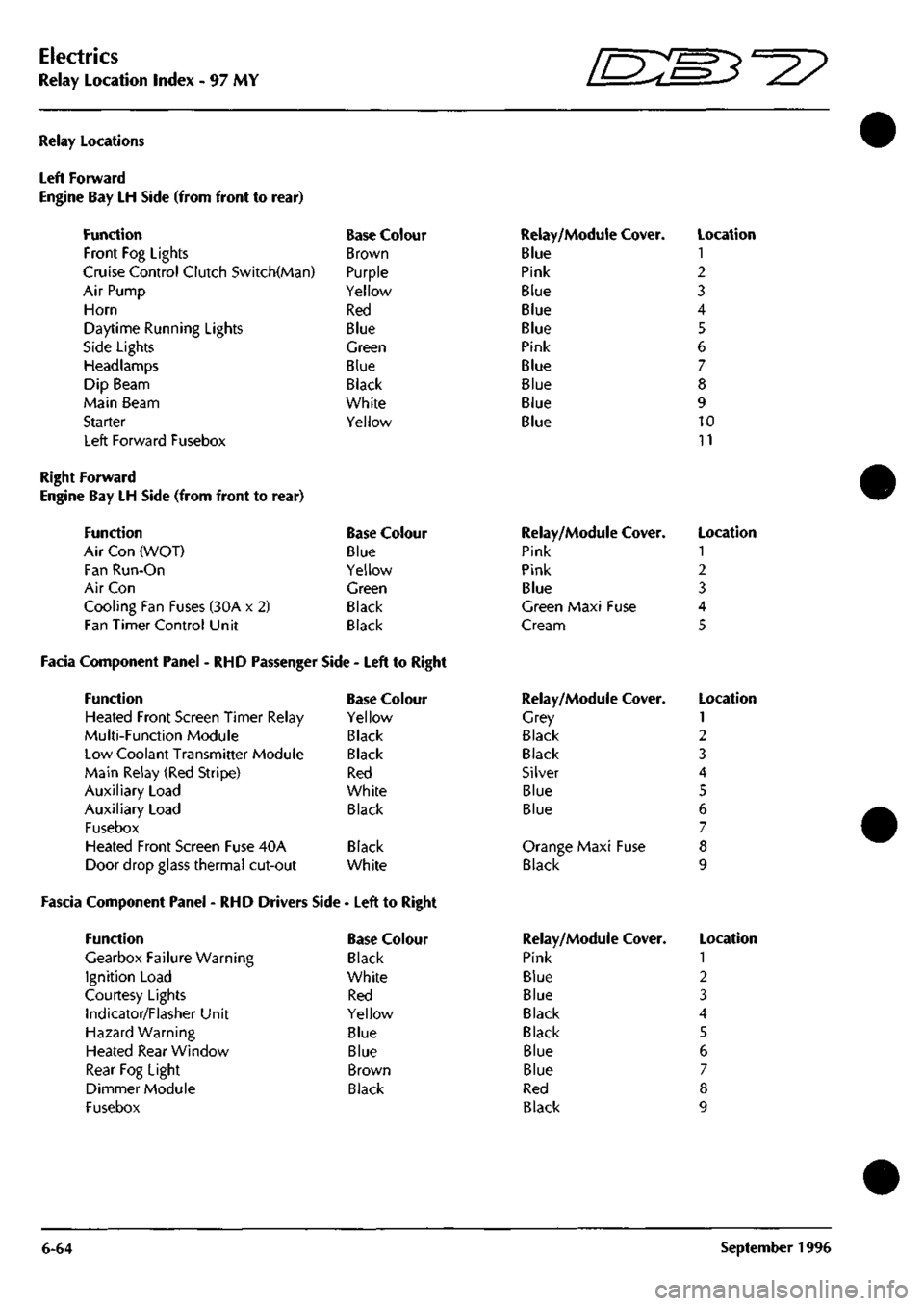
Electrics
Relay Location Index - 97 MY 5^^?
Relay Locations
Left Forward
Engine Bay LH Side (from front to
Function
Front Fog Lights
rear)
Cruise Control Clutch Switch(Man)
Air Pump
Horn
Daytime Running Lights
Side Lights
Headlamps
Dip Beam
Main Beam
Starter
Left Forward Fusebox
Base Colour
Brown
Purple
Yellow
Red
Blue
Green
Blue
Black
White
Yellow
Relay/Module Cover.
Blue
Pink
Blue
Blue
Blue
Pink
Blue
Blue
Blue
Blue
Location
1
2
3
4
5
6
7
8
9
10
11
Right Forward
Engine Bay LH Side (from front to rear)
Function Base Colour
Air Con (WOT) Blue
Fan Run-On Yellow
Air Con Green
Cooling Fan Fuses (30A x 2) Black
Fan Timer Control Unit Black
Facia Component Panel - RHD Passenger Side - Left to Right
Function Base Colour
Heated Front Screen Timer Relay Yellow
Multi-Function Module Black
Low Coolant Transmitter Module Black
Main Relay (Red Stripe) Red
Auxiliary Load White
Auxiliary Load Black
Fusebox
Heated Front Screen Fuse 40A Black
Door drop glass thermal cut-out White
Fascia Component Panel - RHD Drivers Side - Left to Right
Function
Gearbox Failure Warning
Ignition Load
Courtesy Lights
Indicator/Flasher Unit
Hazard Warning
Heated Rear Window
Rear Fog Light
Dimmer Module
Fusebox
Base Colour
Black
White
Red
Yellow
Blue
Blue
Brown
Black
Relay/Module
Pink
Pink
Blue
Cover.
Green Maxi Fuse
Cream
Relay/Module
Grey
Black
Black
Silver
Blue
Blue
Cover.
Orange Maxi Fuse
Black
Relay/Module
Pink
Blue
Blue
Black
Black
Blue
Blue
Red
Black
Cover.
Location
1
2
3
4
5
Location
1
2
3
4
5
6
7
8
9
Location
1
2
3
4
5
6
7
8
9
6-64 September 1996
Page 284 of 421

^^?
Air Conditioning
System Description
System Description
The in-car temperature and humidity are regulated by the electronically controlled air conditioning system. The
system comprises four subsystems:
• heater matrix, supplied with water from the engine cooling system
• refrigeration
• vacuum
• electronic control
Apart from the ambient temperature sensor and the aspirated in-car temperature sensor, most of the components
are housed in the air conditioning unit (Fig. 1) situated behind the dash board, or in the engine compartment.
Figure 1.
Key to Fig. 1 - Left Hand Air Conditioning Unit
1.
Upper feedback potentiometer
2.
Water temperature switch
3. Lower feedback potentiometer
4.
Vacuum valve block
5. Vacuum restrictor
6. Condensate drain tube
Figure 2.
Key to Fig. 2 - Right Hand Air Conditioning Unit
1.
Upper servo motor
2.
Electronic control module
3. Lower servo motor
4.
Evaporator sensor
5. Condensate drain tube
Special Servicing Tools and Equipment
1 PDU system
1 Charging station
1 Leak detector
1 Temperature test box
1 Sanden compressor service tool kit
1 CM Type compressor service tool kit
1 Digital voltmeter
1 Multimeter
May 1996 8-7
Page 286 of 421
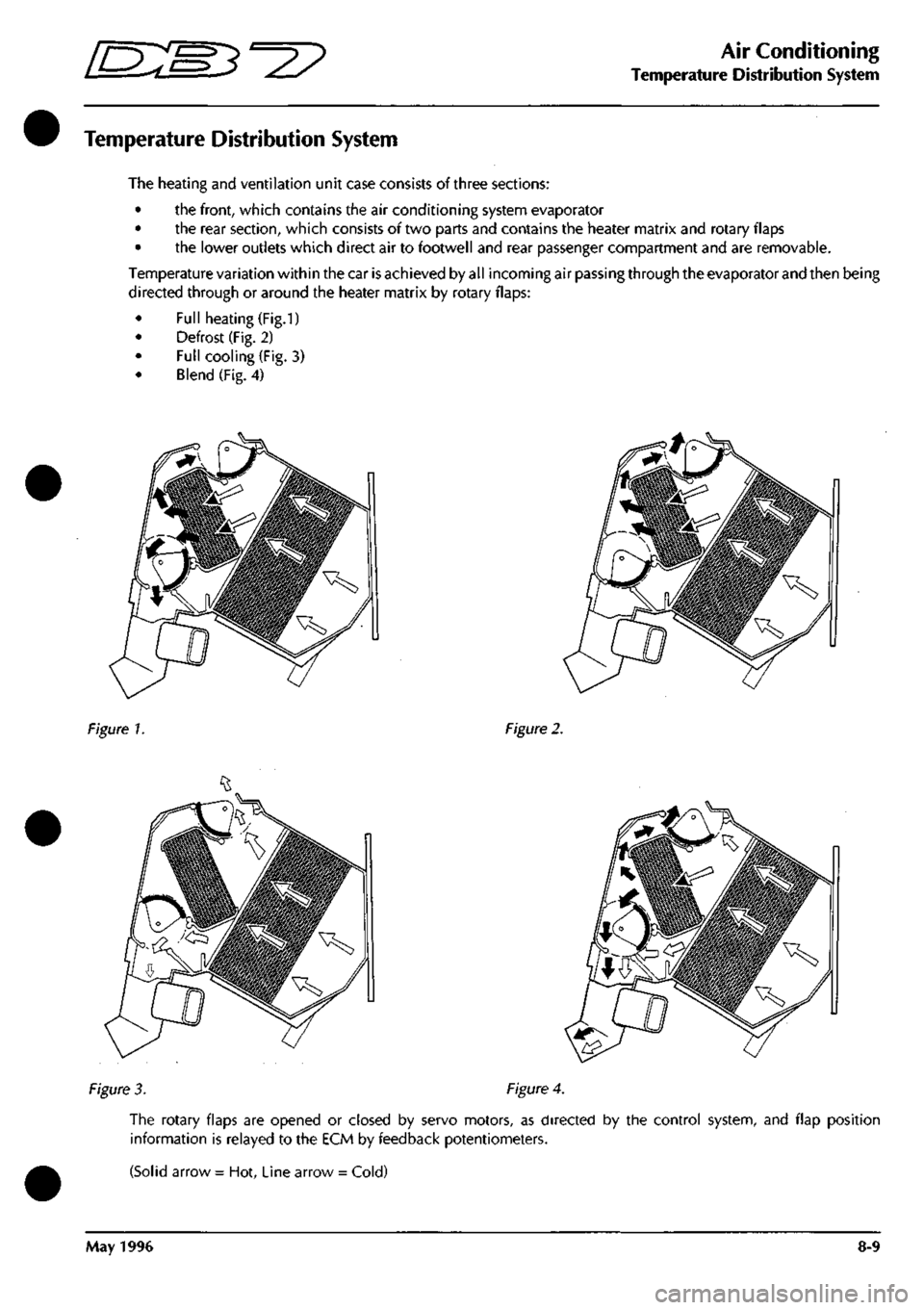
^7
Air Conditioning
Temperature Distribution System
Temperature Distribution System
The heating and ventilation unit case consists of three sections:
• the front, which contains the air conditioning system evaporator
• the rear section, which consists of two parts and contains the heater matrix and rotary flaps
• the lower outlets which direct air to footwell and rear passenger compartment and are removable.
Temperature variation within the car
is
achieved by all incoming air passing through the evaporator and then being
directed through or around the heater matrix by rotary flaps:
• Full heating (Fig.1)
• Defrost (Fig. 2)
• Full cooling (Fig. 3)
Blend (Fig. 4)
Figure 1.
Figure
2.
Figure
3.
Figure
4.
The rotary flaps are opened or closed by servo motors, as directed by the control system, and flap position
information is relayed to the ECM by feedback potentiometers.
(Solid arrow = Hot, Line arrow = Cold)
May 1996 8-9
Page 288 of 421
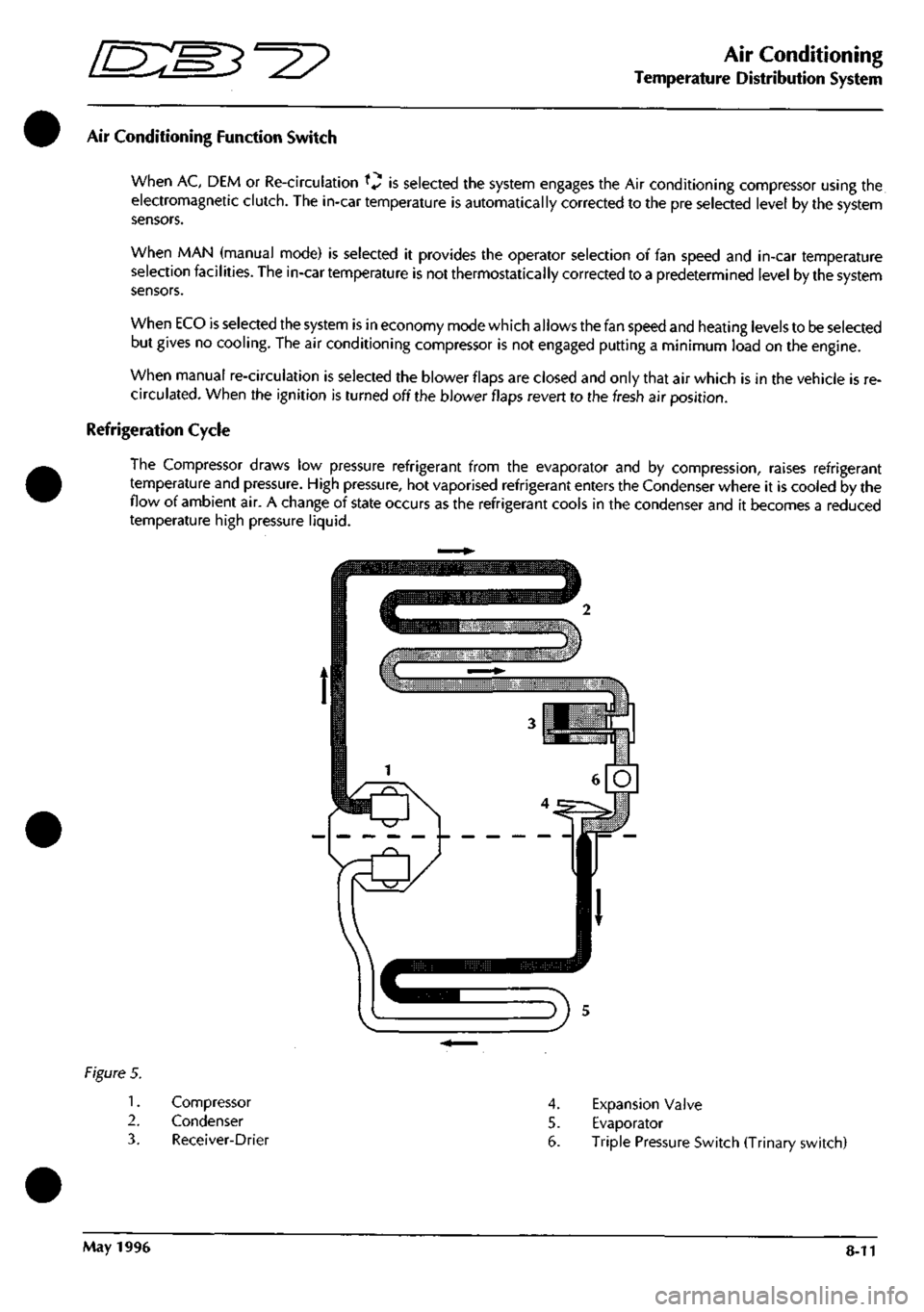
^7
Air Conditioning
Temperature Distribution System
Air Conditioning Function Switch
When AC, DEM or Re-circulation ^v is selected the system engages the Air conditioning compressor using the
electromagnetic clutch. The in-car temperature is automatically corrected to the pre selected level by the system
sensors.
When MAN (manual mode) is selected it provides the operator selection of fan speed and in-car temperature
selection facilities. The in-car temperature is not thermostatically corrected to a predetermined level by the system
sensors.
When ECO is selected the system is in economy mode which allows the fan speed and heating levels to be selected
but gives no cooling. The air conditioning compressor is not engaged putting a minimum load on the engine.
When manual re-circulation is selected the blower flaps are closed and only that air which is in the vehicle is re
circulated.
When the ignition is turned off the blower flaps revert to the fresh air position.
Refrigeration Cycle
The Compressor draws low pressure refrigerant from the evaporator and by compression, raises refrigerant
temperature and pressure. High pressure, hot vaporised refrigerant enters the Condenser where it is cooled by the
flow of ambient air. A change of state occurs as the refrigerant cools in the condenser and it becomes a reduced
temperature high pressure liquid.
Figure 5.
1.
2.
3.
Compressor
Condenser
Receiver-Drier
4.
Expansion Valve
5. Evaporator
6. Triple Pressure Switch (Trinary switch)
May 1996 8-11
Page 289 of 421
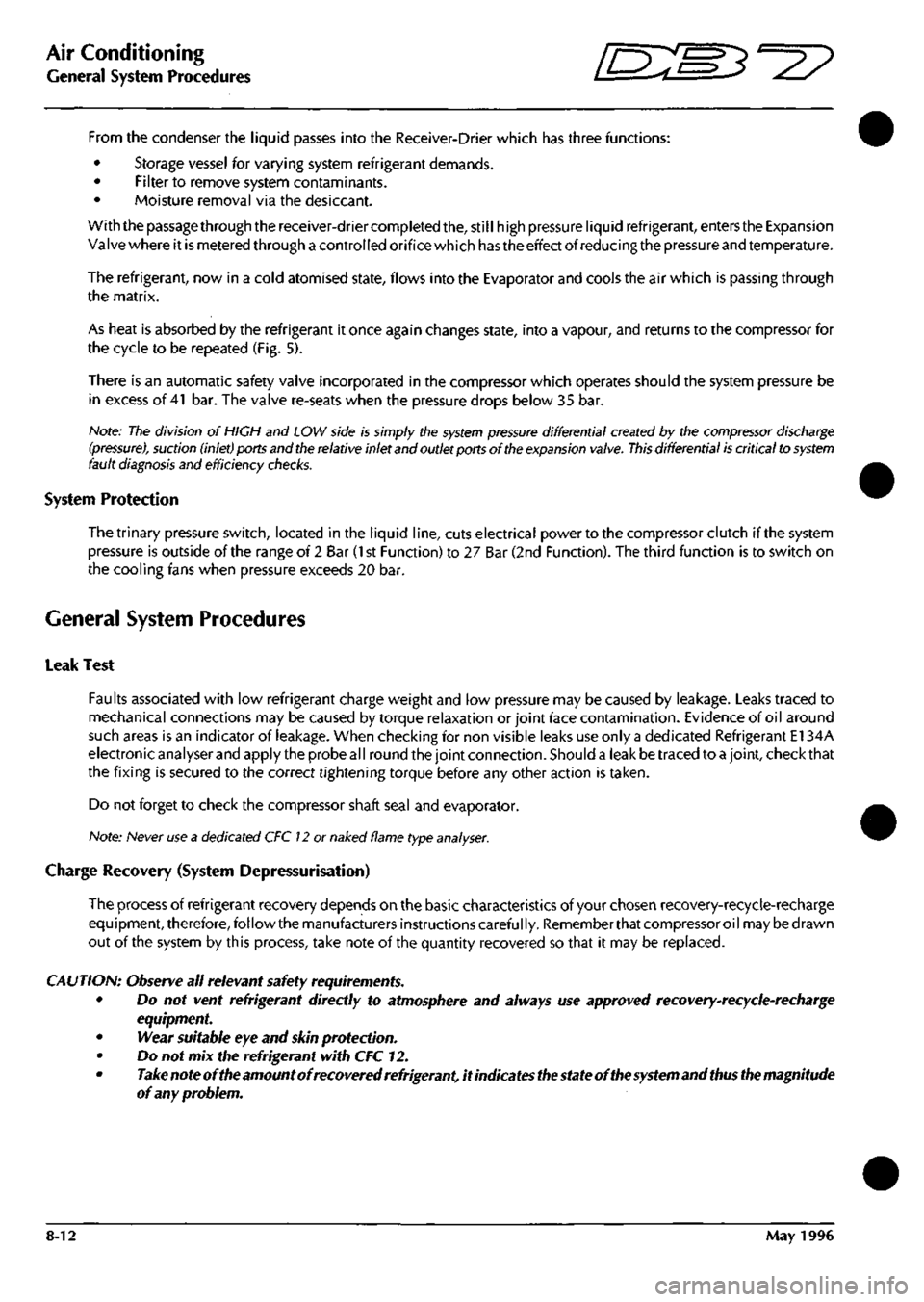
Air Conditioning //~-->> ^/zz:^^ • ^ ^
General Svstem Procedures ' —"^ ^ '^ General System Procedures
From the condenser the liquid passes into the Receiver-Drier which has three functions:
• Storage vessel for varying system refrigerant demands.
• Filter to remove system contaminants.
• Moisture removal via the desiccant.
With the passage through the receiver-drier completed the, still high pressure liquid refrigerant, enters the Expansion
Valve where it is metered through a controlled orifice which has the effect of reducing the pressure and temperature.
The refrigerant, now in a cold atomised state, flows into the Evaporator and cools the air which is passing through
the matrix.
As heat is absorbed by the refrigerant it once again changes state, into a vapour, and returns to the compressor for
the cycle to be repeated (Fig. 5).
There is an automatic safety valve incorporated in the compressor which operates should the system pressure be
in excess of
41
bar. The valve re-seats when the pressure drops below 35 bar.
Note: The division of HIGH and LOW side is simply the
system pressure
differential created by the
compressor
discharge
(pressure),
suction
(inlet)
ports and
the
relative inlet and outlet
ports
of the
expansion
valve.
This
differential is critical to
system
fault
diagnosis
and efficiency checks.
System Protection
The trinary pressure switch, located in the liquid line, cuts electrical power to the compressor clutch if the system
pressure is outside of the range of 2 Bar
(1
st Function) to 27 Bar (2nd Function). The third function is to switch on
the cooling fans when pressure exceeds 20 bar.
General System Procedures
Leak Test
Faults associated with low refrigerant charge weight and low pressure may be caused by leakage. Leaks traced to
mechanical connections may be caused by torque relaxation or joint face contamination. Evidence of oil around
such areas is an indicator of leakage. When checking for non visible leaks use only a dedicated Refrigerant El 34A
electronic analyser and apply the probe all round the joint connection. Should a leak be traced to a joint, check that
the fixing is secured to the correct tightening torque before any other action is taken.
Do not forget to check the compressor shaft seal and evaporator.
Note: Never
use
a dedicated
CFC 12
or
naiced
flame type
analyser.
Charge Recovery (System Depressurisation)
The process of refrigerant recovery depends on the basic characteristics of your chosen recovery-recycle-recharge
equipment, therefore, follow the manufacturers instructions carefully. Remember that compressor oil may be drawn
out of the system by this process, take note of the quantity recovered so that it may be replaced.
CAUTION: Observe all relevant safety requirements.
• Do not vent refrigerant directly to atmosphere and always use approved recovery-recycle-recharge
equipment.
• Wear suitable eye and skin protection.
• Do not mix the refrigerant with CFC 12.
• Take note of the amount of recovered refrigerant, it indica
tes the
state of the
system
and
thus the
magnitude
of any problem.
8-12 May 1996
Page 293 of 421
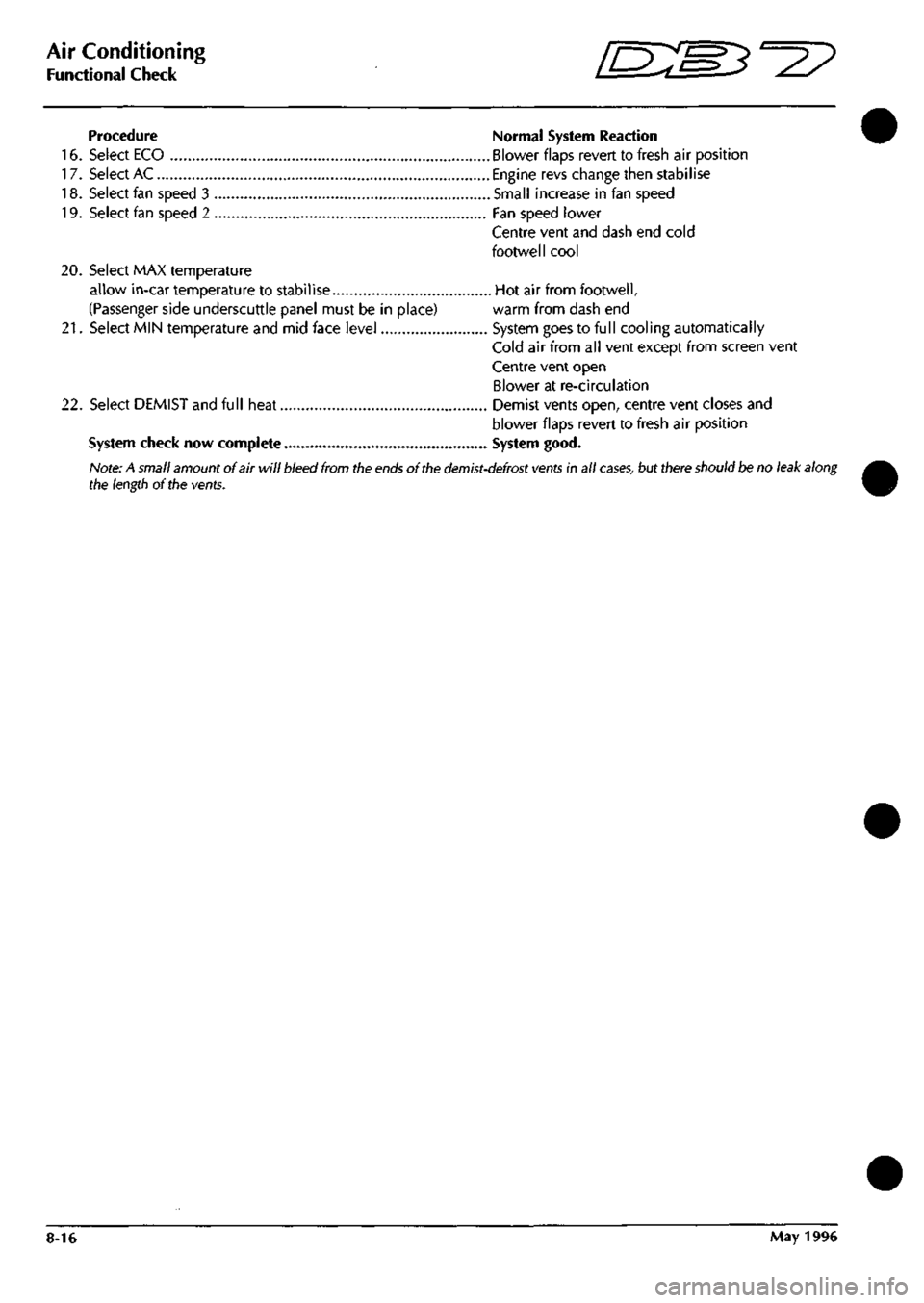
Air Conditioning //—^ ^ci^^ • ^ ^
Fnnrtlnn;il fhprk I *-/ -^ r <
Procedure Normal System Reaction
16.
Select ECO Blower flaps revert to fresh air position
17.
Select AC Engine revs change then stabilise
18.
Select fan speed 3 Small increase in fan speed
19.
Select fan speed 2 Fan speed lower
Centre vent and dash end cold
footwell cool
20.
Select MAX temperature
allow in-car temperature to stabilise Hot air from footwell,
(Passenger side underscuttle panel must be in place) warm from dash end
21.
Select MIN temperature and mid face level System goes to full cooling automatically
Cold air from all vent except from screen vent
Centre vent open
Blower at re-circulation
22.
Select DEMIST and full heat Demist vents open, centre vent closes and
blower flaps revert to fresh air position
System check now complete System good.
Note: A small amount of air will bleed from the
ends
of the
demist-defrost vents
in all
cases,
but there should be no leak along
the length of the vents.
8-16 May 1996
Page 294 of 421
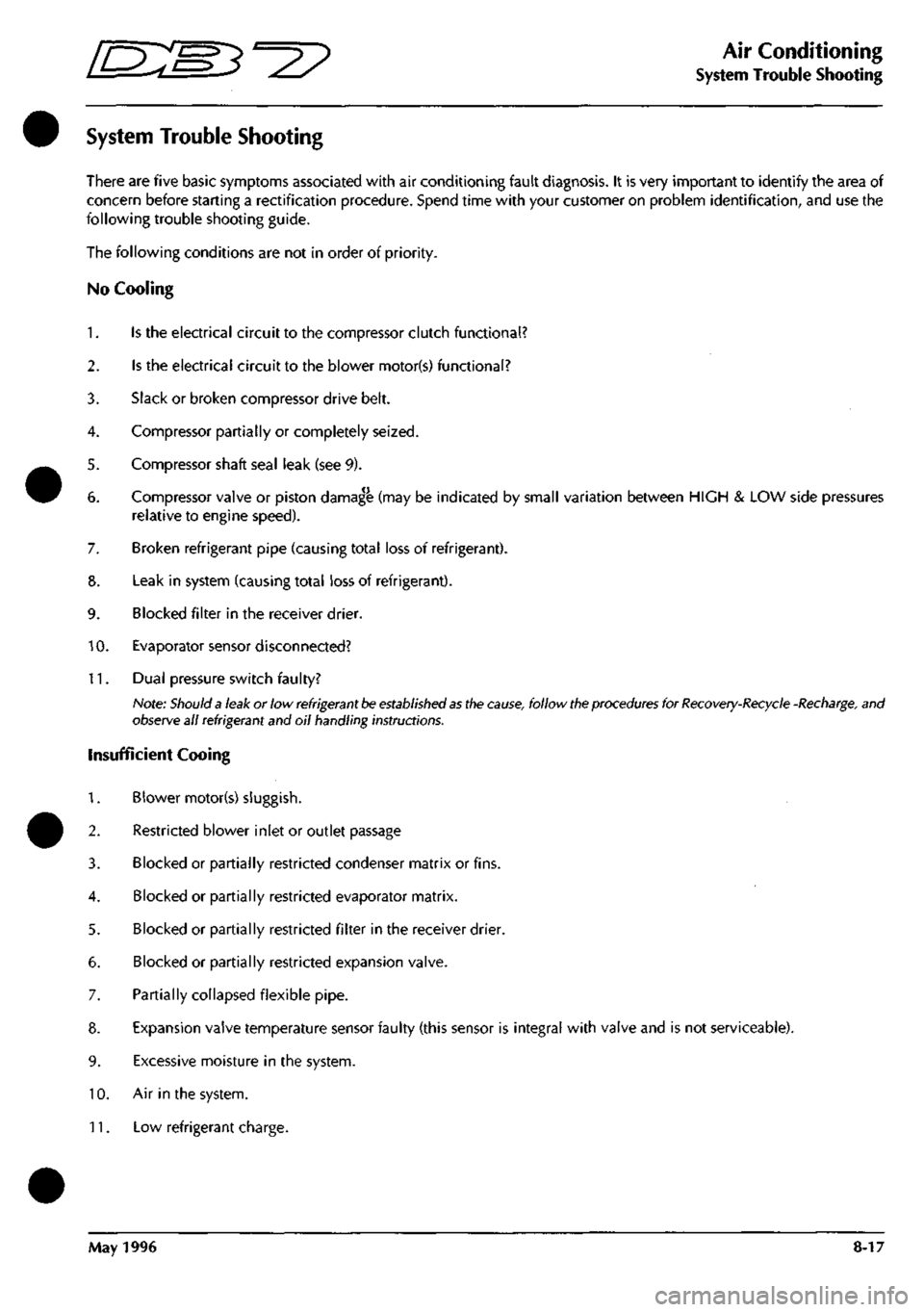
^=2?
Air Conditioning
System Trouble Shooting
System Trouble Shooting
There are five basic symptoms associated with air conditioning fault diagnosis. It is very important to identify the area of
concern before starting a rectification procedure. Spend time with your customer on problem identification, and use the
following trouble shooting guide.
The following conditions are not in order of priority.
No Cooling
1.
Is the electrical circuit to the compressor clutch functional?
2.
Is the electrical circuit to the blower motor(s) functional?
3. Slack or broken compressor drive belt.
4.
Compressor partially or completely seized.
5. Compressor shaft seal leak (see 9).
6. Compressor valve or piston damag^ (may be indicated by small variation between HIGH & LOW side pressures
relative to engine speed).
7. Broken refrigerant pipe (causing total loss of refrigerant).
8. Leak in system (causing total loss of refrigerant).
9. Blocked filter in the receiver drier.
10.
Evaporator sensor disconnected?
11.
Dual pressure switch faulty?
Note:
Should a
leak or low
refrigerant be established as
the
cause,
follow
the procedures
for
Recovery-Recycle
-Recharge,
and
observe all refrigerant and oil handling instructions.
insufficient Cooing
1.
Blower motor(s) sluggish.
2.
Restricted blower inlet or outlet passage
3. Blocked or partially restricted condenser matrix or fins.
4.
Blocked or partially restricted evaporator matrix.
5. Blocked or partially restricted filter in the receiver drier.
6. Blocked or partially restricted expansion valve.
7. Partially collapsed flexible pipe.
8. Expansion valve temperature sensor faulty (this sensor is integral with valve and is not serviceable).
9. Excessive moisture in the system.
10.
Air in the system.
11.
Low refrigerant charge.
May 1996 8-17
Page 295 of 421
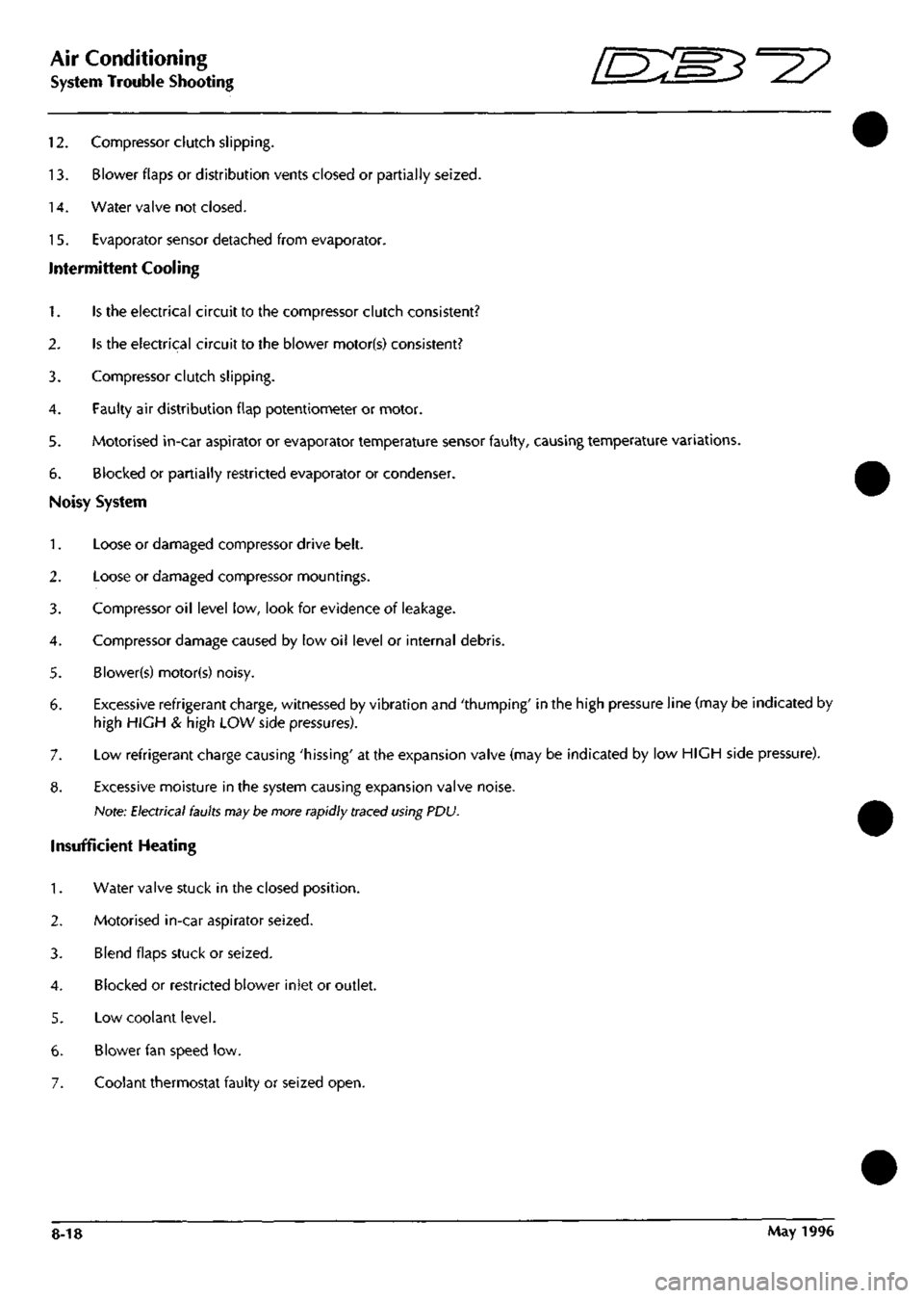
Air Conditioning
/J=y>f^^^
—p )
System Trouble Shooting
12.
Compressor clutch slipping.
13.
Blower flaps or distribution vents closed or partially seized.
14.
Water valve not closed.
15.
Evaporator sensor detached from evaporator.
Intermittent Cooling
Is the electrical circuit to the compressor clutch consistent?
2.
Is the electrical circuit to the blower motor(s) consistent?
3. Compressor clutch slipping.
4.
Faulty air distribution flap potentiometer or motor.
5. Motorised in-car aspirator or evaporator temperature sensor faulty, causing temperature variations.
6. Blocked or partially restricted evaporator or condenser.
Noisy System
1.
Loose or damaged compressor drive belt.
2.
Loose or damaged compressor mountings.
3. Compressor oil level low, look for evidence of leakage.
4.
Compressor damage caused by low oil level or internal debris.
5. Blower(s) motor(s) noisy.
6. Excessive refrigerant charge, witnessed by vibration and 'thumping' in the high pressure line (may be indicated by
high HIGH & high LOW side pressures).
7. Low refrigerant charge causing 'hissing' at the expansion valve (may be indicated by low HIGH side pressure).
8. Excessive moisture in the system causing expansion valve noise.
Note;
Electrical faults
may
be more rapidly traced using PDU.
Insufficient Heating
1.
Water valve stuck in the closed position.
2.
Motorised in-car aspirator seized.
3. Blend flaps stuck or seized.
4.
Blocked or restricted blower inlet or outlet.
5. Low coolant level.
6. Blower fan speed low.
7. Coolant thermostat faulty or seized open.
8-18 May 1996
Page 299 of 421
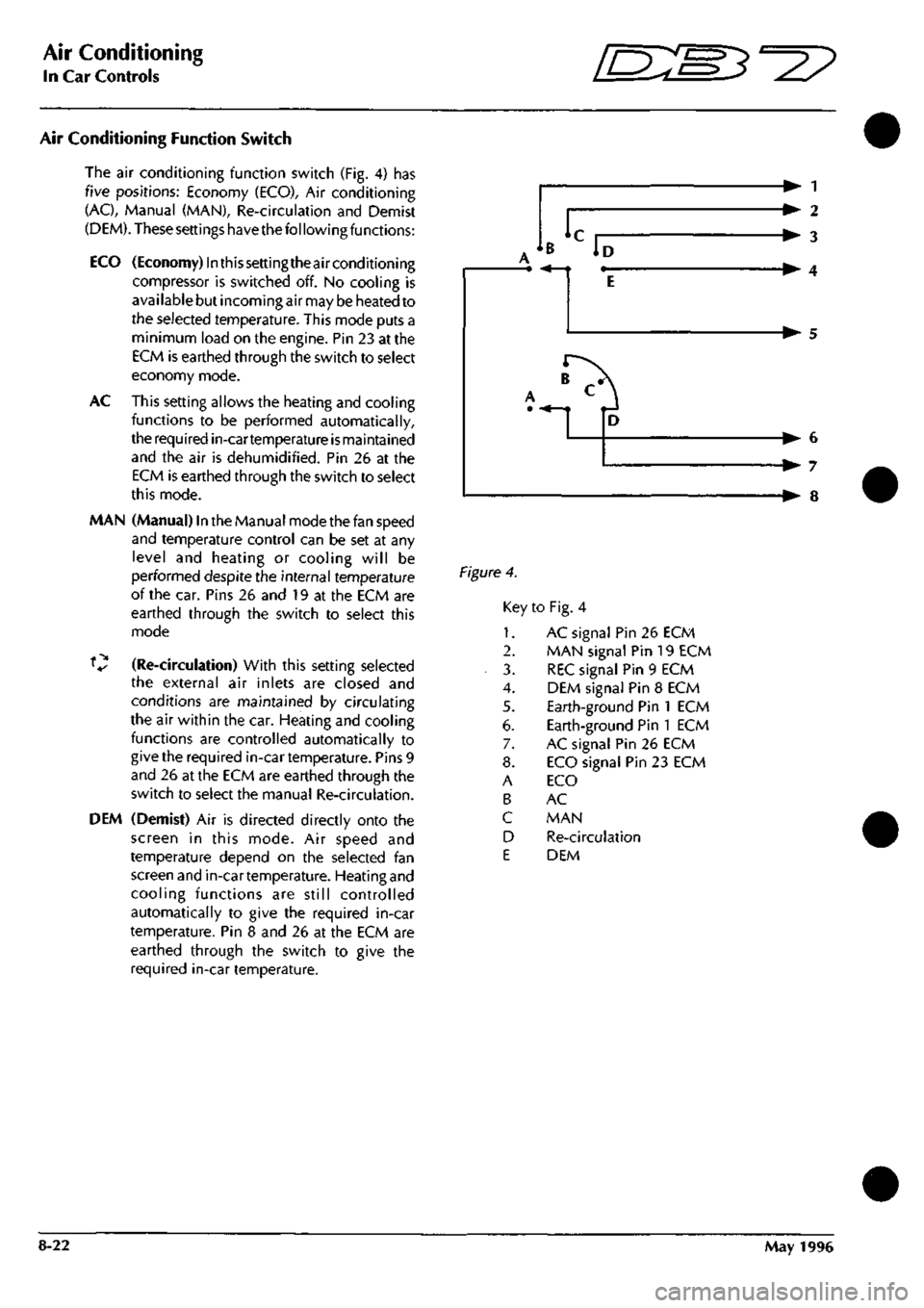
Air Conditioning
In Car Controls '^^
Air Conditioning Function Switch
The air conditioning function switch (Fig. 4) has
five positions: Economy (ECO), Air conditioning
(AC),
Manual (MAN), Re-circulation and Demist
(DEM). These settings have thefol lowing functions:
ECO (Economy) Inthissettingtheairconditioning
compressor is switched off. No cooling is
available but incoming air may be heated to
the selected temperature. This mode puts a
minimum load on the engine. Pin 23 at the
ECM is earthed through the switch to select
economy mode.
AC This setting allows the heating and cooling
functions to be performed automatically,
the required in-cartemperature
is
maintained
and the air is dehumidified. Pin 26 at the
ECM is earthed through the switch to select
this mode.
MAN (Manual) In the Manual mode the fan speed
and temperature control can be set at any
level and heating or cooling will be
performed despite the internal temperature
of the car. Pins 26 and 19 at the ECM are
earthed through the switch to select this
mode
V (Re-circulation) With this setting selected
the external air inlets are closed and
conditions are maintained by circulating
the air within the car. Heating and cooling
functions are controlled automatically to
give the required in-cartemperature. Pins 9
and 26 at the ECM are earthed through the
switch to select the manual Re-circulation.
DEM (Demist) Air is directed directly onto the
screen in this mode. Air speed and
temperature depend on the selected fan
screen and in-cartemperature. Heating and
cooling functions are still controlled
automatically to give the required in-car
temperature. Pin 8 and 26 at the ECM are
earthed through the switch to give the
required in-car temperature.
B
liD^
-• 1
-• 2
-• 3
-• 4
-• 5
,'^
1 -• 6
-• 7
-• 8
Figure 4.
Key to Fig. 4
1.
AC signal Pin 26 ECM
2.
MAN signal Pin 19 ECM
3. REC signal Pin 9 ECM
4.
DEM signal Pin 8 ECM
5. Earth-ground Pin 1 ECM
6. Earth-ground Pin 1 ECM
7. AC signal Pin 26 ECM
8. ECO signal Pin 23 ECM
A ECO
B AC
C MAN
D Re-circulation
E DEM
8-22 May 1996
Page 311 of 421
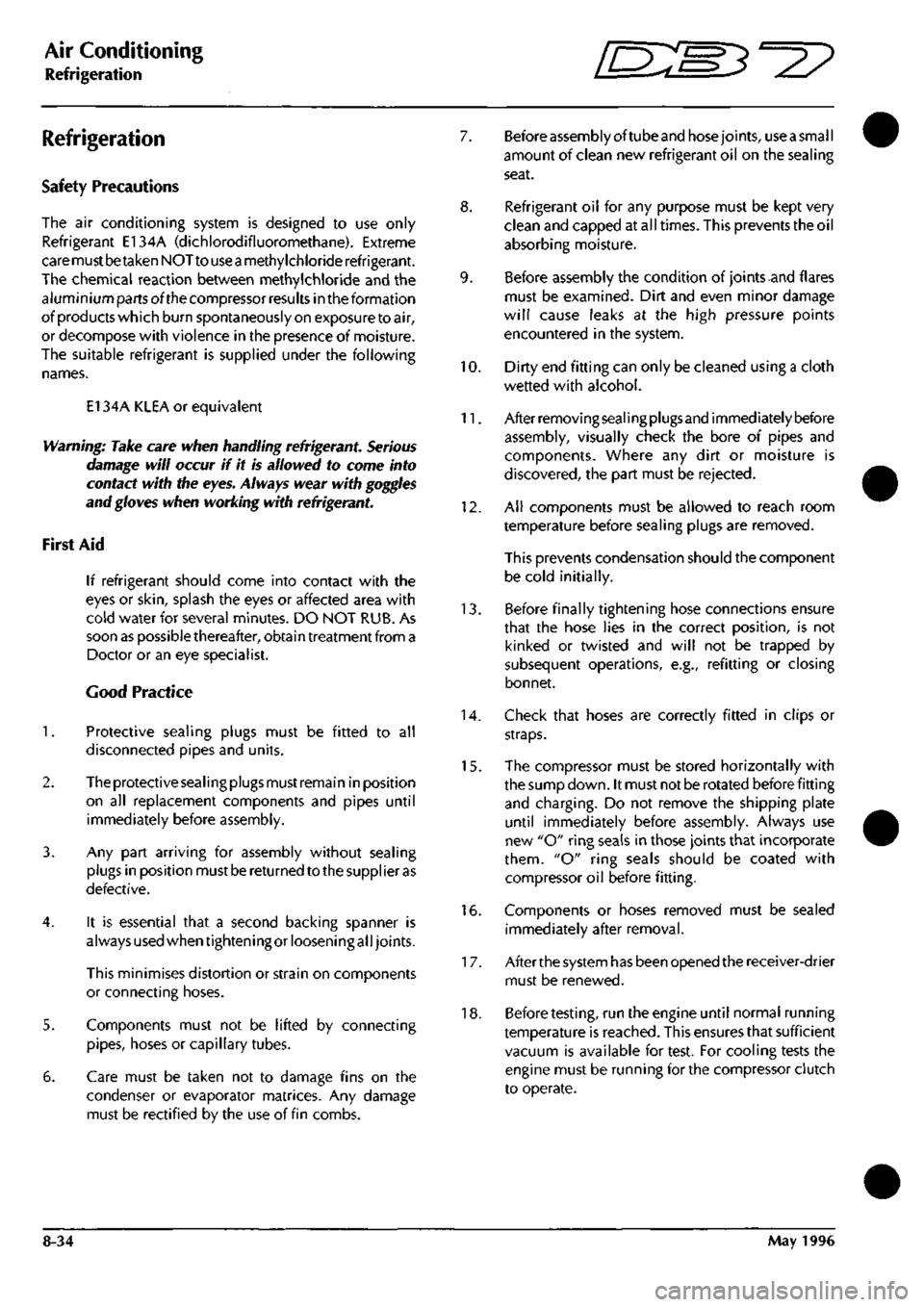
Air Conditioning
Refrigeration /s:s^°27
Refrigeration
Safety Precautions
The air conditioning system is designed to use only
Refrigerant E134A (dichlorodifluoromethane). Extreme
care must betaken NOT to use
a
methylchloride refrigerant.
The chemical reaction between methylchloride and the
aluminium parts ofthe compressor results in the formation
ofproductswhich burn spontaneously on exposure toair,
or decompose with violence in the presence of moisture.
The suitable refrigerant is supplied under the following
names.
El 34A KLEA or equivalent
Warning: Take care when handling refrigerant. Serious
damage will occur if it is allowed to come into
contact with the eyes. Always wear with goggles
and gloves when working with refrigerant
First Aid
If refrigerant should come into contact with the
eyes or
skin,
splash the eyes or affected area with
cold water for several minutes. DO NOT RUB. As
soon as possible thereafter, obtain treatment from a
Doctor or an eye specialist.
Good Practice
1.
Protective sealing plugs must be fitted to all
disconnected pipes and units.
2.
Theprotectivesealingpiugsmustremain inposition
on ail replacement components and pipes until
immediately before assembly.
3. Any part arriving for assembly without sealing
plugs in position must be returned to the supplier as
defective.
4.
It is essential that a second backing spanner is
always used when tightening or loosening all joints.
This minimises distortion or strain on components
or connecting hoses.
5. Components must not be lifted by connecting
pipes,
hoses or capillary tubes.
6. Care must be taken not to damage fins on the
condenser or evaporator matrices. Any damage
must be rectified by the use of fin combs.
7. Before assembly oftube and hosejoints, use
a
small
amount of clean new refrigerant oil on the sealing
seat.
8. Refrigerant oil for any purpose must be kept very
clean and capped at all times. This prevents the oil
absorbing moisture.
9. Before assembly the condition of joints and flares
must be examined. Dirt and even minor damage
will cause leaks at the high pressure points
encountered in the system.
10.
Dirty end fitting can only be cleaned using a cloth
wetted with alcohol.
11.
Afterremovingsealingplugsand immediatelybefore
assembly, visually check the bore of pipes and
components. Where any dirt or moisture is
discovered,
the part must be rejected.
12. Ail components must be allowed to reach room
temperature before sealing plugs are removed.
This prevents condensation should the component
be cold initially.
13.
Before finally tightening hose connections ensure
that the hose lies in the correct position, is not
kinked or twisted and will not be trapped by
subsequent operations, e.g., refitting or closing
bonnet.
14.
Check that hoses are correctly fitted in clips or
straps.
15.
The compressor must be stored horizontally with
the sump down. It must not be rotated before fitting
and charging. Do not remove the shipping plate
until immediately before assembly. Always use
new "O" ring seals in those joints that incorporate
them.
"O" ring seals should be coated with
compressor oil before fitting.
16.
Components or hoses removed must be sealed
immediately after removal.
1 7. Afterthe system has been opened the receiver-drier
must be renewed.
18.
Before
testing,
run the engine until normal running
temperature is reached. This ensures that sufficient
vacuum is available for test. For cooling tests the
engine must be running for the compressor clutch
to operate.
8-34 May 1996